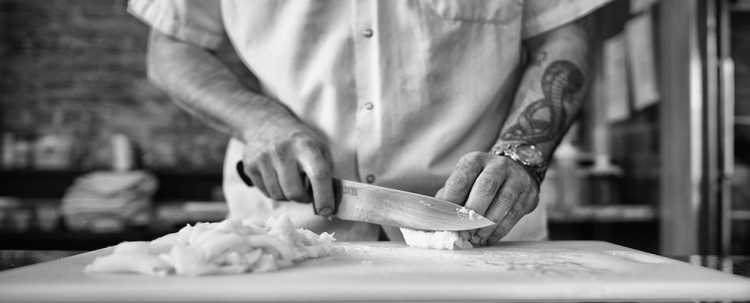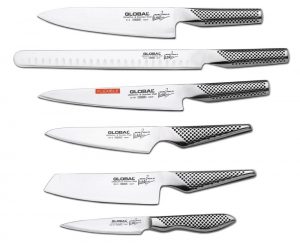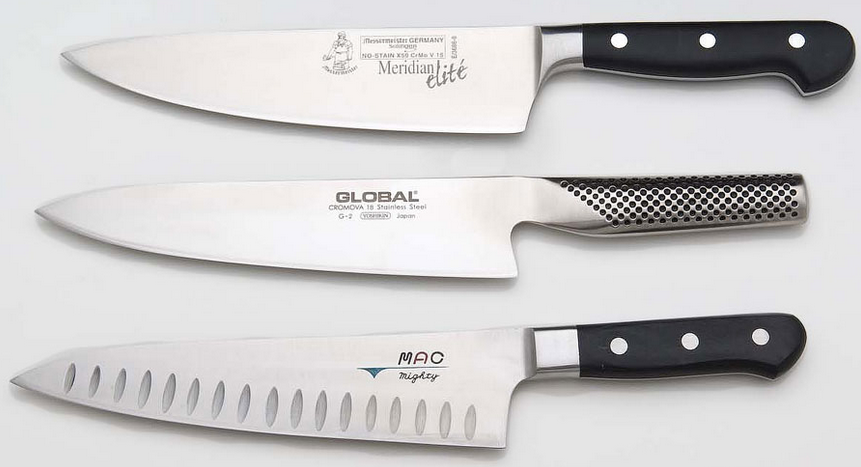Gentleman’s Kitchen: Complete Guide to Knives

It’s time to upgrade your knives, my friend.
It’s not true for all men out there, but most of you have the same knife set you bought at Target when it was on an end-cap on sale… 10 years ago. While there’s nothing wrong with a great sale, sometimes you have to swallow that you get what you pay for pill to get through it. Just because they’re not rusted or broken, doesn’t mean you should hold onto them. Donate them to a shelter or community kitchen and move onto bigger and sharper things.
You may be asking why you should embrace such advice with reckless abandon. There are a few reasons to upgrade:
- Precisely made, very sharp knives make cooking easier and more fun
- You will find yourself cooking more just to experience the knives again
- There are few things manlier than knowing your way around the kitchen and wielding a very sharp knife
 With all the options out there, and all of them at varying costs, it can be hard to know what you should and shouldn’t invest in when upgrading. To make this a little easier, you can either buy a complete set or build your collection one-at-a-time. If you choose to do the latter, there are really only three essential knives to make your cutlery exponentially better. Consider this a jumping-off point in your complete guide to knives in the kitchen.
With all the options out there, and all of them at varying costs, it can be hard to know what you should and shouldn’t invest in when upgrading. To make this a little easier, you can either buy a complete set or build your collection one-at-a-time. If you choose to do the latter, there are really only three essential knives to make your cutlery exponentially better. Consider this a jumping-off point in your complete guide to knives in the kitchen.
Three Knives to Rule Them All
You don’t need a wooden-block knife set to upgrade the bad-ass level of your kitchen, so don’t fret about not having a complete collection right now. These three knives are the Chef’s knife, the Paring knife, and the Bread knife – which are listed below in order of importance.
The Chef’s Knife

The single, most important tool in a serious cook’s kitchen (whether it’s at home or he’s actually a cook) is his Chef’s knife. Ask him and he’ll tell you the same thing. It is built to tackle nearly any job, and it’s not something he would ever discount to cut corners (although his knife is sharp enough to cut corners as well – yes, pun intended).
The Chef’s knife, also known as a cook’s knife or French knife, ranges from 6–12″ in length, but 8–10″ is by far the most common and generally most comfortable to use. Width and shape differ by region and preference. The three main designs come out of Germany, France, and Japan. Blade shape is designed for optimal cutting technique. You can see the three designs below:

The German-made knife typically has a wide blade with a pronounced curve as it nears the tip. This is referred to as a “big belly.” A French-style knife is slimmer and straighter, and has a triangular blade that makes it an ideal tool for chopping and slicing. The Santoku is the Japanese version of a Chef’s knife, and is visibly different from the other two in two distinct areas: the spine is usually curved while the cutting edge is typically straight, and the blade has flutes along the surface to allow for paper-thin slicing and prevent food from sticking to it. It also tends to be a shorter knife than its European cousins.
I have a Santoku and a French version in my kitchen, and I cannot say enough about them. The Santoku makes slicing a breeze, and the larger French knife allows me to put a little more blade into the meats and pieces I’m cutting. Both are an asset in my kitchen, and they’ll be the same in yours.
The Paring Knife
Though the Paring knife is significantly smaller, it’s not to be taken lightly. This little, but mighty blade is a cook’s best friend when it comes to small jobs. I grew up thinking it was used to peel vegetables (my mother was a master at prepping potatoes with a paring knife when I was a kid), but it’s far more amazing.
It’s a brilliant kitchen companion when hulling strawberries, trimming mushrooms, peeling and slicing small fruits and vegetables, and filleting soft meats like fish. Paring knives typically come in 2–4″ lengths, with 3 ½ inches considered ideal for most chefs. A spear-shaped blade is generally the most useful, but these knives also come in the same shapes as chef’s knives.
The Bread Knife
The best way to determine how valuable this knife is to your collection is to review how many times you’ve crushed bread trying to slice it with some other knife from the block. I’ll bet you’ve had spaghetti with garlic bread and you ended up with squished bread on your plate, didn’t you? You had the best of intentions, right?
In walks the bread knife, all serrated or scalloped from tip to heel, and he’s ready to do business. More than just a great way to slice bread, the knife is ideal for cutting foods that need to be sawed. Typically 10–12″ in length, it is also the perfect knife for getting into hard-rind fruits like pineapple, with a single pull.
OtherSpecialty Knives
The Carving or Slicing Knife
More often than not, this knife is approximately the same length as the bread knife, but the serrated edge has been replaced with a honed-sharp blade. This is ideal for carving or slicing large pieces of meat like Thanksgiving turkey because the blade length and sharpness allow for effortless cutting with minimal movement.
The Fillet Knife
The fillet knife is an amazing addition to any collection because its flexibility makes it a master in nearly any carving situation. Typically 6–8″ in length, this knife is ideal at moving around curved areas like pork shoulders and fish bones.
The Boning Knife
Similar to the Fillet knife, this knife is perfect for slicing meat around muscle and cleaning up around bone. It is also typically 6–8″ in length and curves up to a fine point at the tip.
The Vegetable Knife
The Vegetable knife is designed to make slicing and prepping vegetables a breeze because it has a 6–8″ length and a nearly flat blade surface. This allows it to make sure fruits and vegetables (and other things) are sliced all the way through, along their entire length. I find this is a very comfortable knife to use in my kitchen. The larger blade height also makes it a pretty good little shelf for transporting things from the cutting board to the stove.
I know this may sound a little far-fetched, but better knives will make you a better cook. When you’re using better equipment, you pay closer attention to things; you put in more effort; you want to give it all you’ve got. It’s just like getting a new pair of shoes when you were a kid. You swear they made you run faster, right? No, you just got excited and ran your ass off. You were a better runner, but it was because you were excited to try.
Get yourself some manly knives, gentlemen, and become a better cook. At the very least, you’ll be excited to try.










